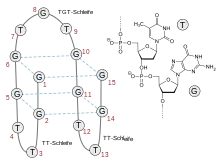 | |
| Clinical data | |
|---|---|
| Other names | Rovunaptabin
|
| Routes of administration | Infusion |
| Pharmacokinetic data | |
| Elimination half-life | 2.9-11 min |
| Identifiers | |
| |
| CAS Number |
|
| PubChem CID | |
| PubChem SID | |
| DrugBank | |
| ChEBI | |
| Chemical and physical data | |
| Formula | C150H188N57O97P15 |
| Molar mass | 4806.062 g·mol−1 |
| 3D model (JSmol) | |
| |
| |
BC-007 is an oligonucleotide aptamer, a synthetic DNA compound designed to bind other chemicals.[1] BC-007 is in early-stage clinical trials as a lead compound intended for the potential treatment of heart failure or long COVID. The international nonproprietary name is rovunaptabin.[2]
History
Since the 1990s, GPCR autoantibodies were investigated as possible factors in the pathology of several diseases, including heart disease.[3][4] In parallel, treatment strategies to remove GPCR-AABs were investigated, initially using proteins or peptides to bind the antibodies.[5][6]
In 2013, scientists from the Max Delbrück Center and the Charité Heart Center reported using aptamers as a treatment for dilated cardiomyopathy in people positive for beta-1 adrenergic receptor AABs.[7][8] In 2015–16, scientists reported that two aptamers might bind GPCR-AABs, possibly resulting in an inhibition of GPCR-AABs.[9][10]
The biotechnology company Berlin Cures pursued the development of the aptamer with the nucleotide sequence GGT TGG TGT GGT TGG under the codename BC-007 for the inhibition of autoantibodies in cardiomyopathy.[11]
Properties
BC-007 is a 15-nucleotide single-stranded DNA molecule consisting of nine unmodified deoxy-guanosines and six corresponding deoxythymidines with the sequence 5'-GGT TGG TGT GGT TGG-3'.[1] Its three-dimensional structure allows it to wrap around the target structure of functionally active G-protein-coupled receptor autoantibodies and neutralize their activity.[1]
BC-007 can be synthetically produced, and is considered safe.[1][11] In preliminary human studies, it was given by intravenous infusion and had an in vivo plasma half-life of around 4 minutes.[1]
Research
Heart failure
The removal of pathogenic functional autoantibodies through a medical blood purification procedure, known as immunoadsorption, can stabilize heart function in people with dilated cardiomyopathy who are awaiting heart transplantation.[12][13] In 2018, a Phase I clinical trial found that BC-007 was well-tolerated, with no serious adverse events reported.[1][11] Phase IIa trials demonstrated that BC-007 could neutralize the activity of functional autoantibodies in most subjects treated.[14]
Long COVID
BC-007 is under investigation as a possible agent for treating disorders of long COVID.[15]
References
- 1 2 3 4 5 6 Kolter T (2023). "BC-007". In Böckler F, Dill B, Eisenbrand G, Faupel F, Fugmann B, Gamse T, et al. (eds.). Römpp [Online]. Georg Thieme Verlag.
- ↑ Programme on International Nonproprietary Names (INN), ed. (2023-08-06). WHO Drug Information - INN Proposed List 129. Vol. 37. INN and Classification of Medical Products (INN). World Health Organization. Archived from the original (PDF) on 2023-08-06. Retrieved 2023-12-31.
- ↑ Matsui S, Fu ML (May 1998). "Myocardial injury due to G-protein coupled receptor-autoimmunity". Japanese Heart Journal. 39 (3): 261–274. doi:10.1536/ihj.39.261. PMID 9711178. S2CID 22133040.
- ↑ Bornholz B, Wallukat G, Roggenbuck D, Schimke I (2017-02-17). "Chapter 3 - Autoantibodies Directed Against G-Protein-Coupled Receptors in Cardiovascular Diseases: Basics and Diagnostics". In Nussinovitch U (ed.). The Heart in Rheumatic, Autoimmune and Inflammatory Diseases. Academic Press. pp. 49–63. doi:10.1016/B978-0-12-803267-1.00003-X. ISBN 978-0-12-803267-1.
- ↑ Wallukat G, Müller J, Hetzer R (November 2002). "Specific removal of beta1-adrenergic autoantibodies from patients with idiopathic dilated cardiomyopathy". The New England Journal of Medicine. 347 (22): 1806. doi:10.1056/NEJM200211283472220. PMID 12456865.
- ↑ Doesch AO, Konstandin M, Celik S, Kristen A, Frankenstein L, Hardt S, et al. (2009-07-09). "Effects of protein A immunoadsorption in patients with advanced chronic dilated cardiomyopathy". Journal of Clinical Apheresis. 24 (4): 141–149. doi:10.1002/jca.20204. PMID 19591221. S2CID 5566530.
- ↑ Haberland A, Wallukat G, Schimke I (March 2013). "The patent situation concerning the treatment of diseases associated with autoantibodies directed against G-protein-coupled receptors". Pharmaceutical Patent Analyst. 2 (2): 231–248. doi:10.4155/ppa.12.88. PMID 24237028.
- ↑ Patel PA, Hernandez AF (July 2013). "Targeting anti-beta-1-adrenergic receptor antibodies for dilated cardiomyopathy". European Journal of Heart Failure. 15 (7): 724–729. doi:10.1093/eurjhf/hft065. PMC 3707431. PMID 23639780.
- ↑ Haberland A, Holtzhauer M, Schlichtiger A, Bartel S, Schimke I, Müller J, et al. (October 2016). "Aptamer BC 007 - A broad spectrum neutralizer of pathogenic autoantibodies against G-protein-coupled receptors". European Journal of Pharmacology. 789: 37–45. doi:10.1016/j.ejphar.2016.06.061. PMID 27375076.
- ↑ Wallukat G, Müller J, Haberland A, Berg S, Schulz A, Freyse EJ, et al. (January 2016). "Aptamer BC007 for neutralization of pathogenic autoantibodies directed against G-protein coupled receptors: A vision of future treatment of patients with cardiomyopathies and positivity for those autoantibodies". Atherosclerosis. 244: 44–47. doi:10.1016/j.atherosclerosis.2015.11.001. PMID 26584137.
- 1 2 3 "Berlin Cures Announces Successful Completion of Phase 1 Study of BC 007 for the Treatment of Cardiomyopathy". BioSpace. 22 August 2018. Retrieved 30 May 2023.
- ↑ Werner S, Wallukat G, Becker NP, Wenzel K, Müller J, Schimke I, Wess G (June 2020). "The aptamer BC 007 for treatment of dilated cardiomyopathy: evaluation in Doberman Pinschers of efficacy and outcomes". ESC Heart Failure. 7 (3): 844–855. doi:10.1002/ehf2.12628. PMC 7261533. PMID 32212256.
- ↑ Dandel M, Wallukat G, Englert A, Lehmkuhl HB, Knosalla C, Hetzer R (December 2012). "Long-term benefits of immunoadsorption in β(1)-adrenoceptor autoantibody-positive transplant candidates with dilated cardiomyopathy". European Journal of Heart Failure. 14 (12): 1374–1388. doi:10.1093/eurjhf/hfs123. PMID 22892122.
- ↑ Düngen HD, Dordevic A, Felix SB, Pieske B, Voors AA, McMurray JJ, Butler J (January 2020). "β1-Adrenoreceptor Autoantibodies in Heart Failure: Physiology and Therapeutic Implications". Circulation. Heart Failure. 13 (1): e006155. doi:10.1161/CIRCHEARTFAILURE.119.006155. PMID 31957469. S2CID 210831160.
- ↑ Becker NP, Haberland A, Wenzel K, Göttel P, Wallukat G, Davideit H, et al. (May 2020). "A Three-Part, Randomised Study to Investigate the Safety, Tolerability, Pharmacokinetics and Mode of Action of BC 007, Neutraliser of Pathogenic Autoantibodies Against G-Protein Coupled Receptors in Healthy, Young and Elderly Subjects". Clinical Drug Investigation. 40 (5): 433–447. doi:10.1007/s40261-020-00903-9. PMC 7181550. PMID 32222912.